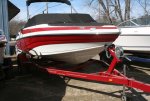- Joined
- Jul 18, 2011
- Messages
- 17,705
T. Penfield, your post showing the relative slope of a Sting Ray bowrider and a Sea Hunt dual console is exactly the post I was looking for. Have it saved as a favourite now.
I think the ability of a boat to cut through waves is dependent on the angle of entry of the bow and if the bow slopes up from the stern. A Sea Hunt or a Key West is the 1st choice because of the 50 degree entry angle and bow sloping up. I may have to make a 2nd choice though and wanted to know if there is there a good resource for looking up the bow entry angle and bow slope of various other boats? This information and bridge clearance seem to be hard to find.
One 2nd choice boat I am considering is the Crestliner 19 XS with an outboard.
Don't know about the bow entry angle or bow slope.
If possible can you work your magic on showing the bow angle with the yellow and red lines? How do you do that? Knowing the bow entry angle
I was not able to find the exact model of Crestliner, but similar models look like 'river' boats. Probably not what you want on bays and the ocean.

























